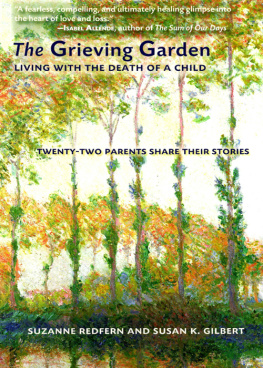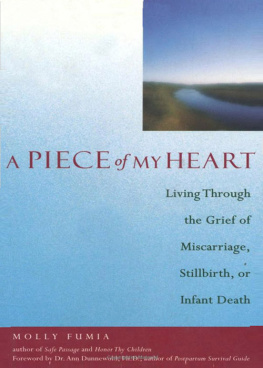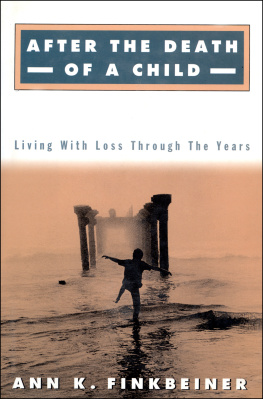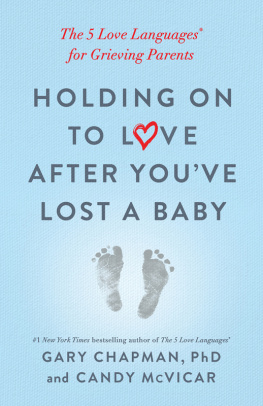PRAISE FOR THE GRIEVING GARDEN
Grieving parents Redfern and Gilbert, along with 20 others, fill a void in the literature of child loss that both discovered after the death of a daughter; having devoured every grief-related bit of writing, they found no relief for their escalating isolation: What I needed wasn't information, but company Unadorned by expert commentary, Redfern and Gilbert address directly the personal experience of living out a parent's worst fearwith the voices of those who have. Organized by issue (24, in six sections) rather than contributor, it's easy to find a wide variety of perspectives on specific challenges (Surviving the First Few Days Pursuing Counseling Encountering the Voidand Continuing the Connection). Parents take turns weighing in on each issue in conversationalfirst-personcontributions (most solicited in written interviews), occasionally including journal entries, verse and straightforward guidance (especially helpful is the long view provided by Martin Katz, whose son died in 1981). A More About Ussection provides photos and brief profiles. A variety of backgrounds and circumstances, along with a shared dedication to speak out on a notoriously unspeakable loss, make this brave volume cathartic and comforting; grieving parents may well find it invaluable.
Publishers Weekly starred review, March 24, 2008
It's hard to imagine anything worse than the death of a child. Redfern and Gilbert reflect on their own experiences with such a tragedy and recount the stories of 20 other parents whose children died at a variety of ages and from causes ranging from disease and accidents to suicide and terrorism. The authors organize the interviews in a way that mirrors the stages of the grieving process, including immediate reactions, seeking support, effects on family life and relationships, integrating the loss into one's life, and maintaining connections with a loved one. Simple words, carefully edited, convey eloquent and practical insights into the bereavement experience. Ultimately, this book shows that comfort, healing, and even growth are possible after the death of a child. This powerfully authentic book is highly recommended for large public libraries and counseling collections.
Library Journal starred review, March 24, 2008
This searingly poignant volume uses the words of bereaved parents to bring to life every parent's worst nightmare, the loss of a child. Thoughtfully organized to be of practical use and comfort to those facing such tragedies (or those who would help them), it is a unique contribution and will be of immeasurable value and consolation. Should be in the library of all who might encounter bereaved parents.
-John Ruark, MD, Clinical Associate Professor of Psychiatry, Stanford University Medical School; Thanatologist; Medical Ethicist; and award-winning author of Dying Dignified: The Health Professional's Guide to Care
This important book shines new light on the turmoil created by the loss of a child, and on its potential for personal transformation. Moving and evocative.
The Reverend Scotty McLennan, Dean for Religious Life, Stanford University
What I hear from bereaved parents themselves, as well as from the professionals, friends, and family members who struggle to help them heal, convinces me that The Grieving Garden will fill an important need. It's a grief support group that readers can attend in the privacy of their own homes, for as long or short a time as they wish, at any time of the day or night that they need the support.
Liz Powell, Director of Youth and Family Services, KARA (a non-profit grief support foundation on the San Francisco Peninsula)
Reading The Grieving Garden ten years after my adult son Tom died took me through a process of rehealing my broken heart. It was a treasure unmatched in all that time. My husband read it, too. Though he never met my son, the book helped him understand why we keep Tom's name alive in our household and why I so tenderly nurture the nectarine tree he gave me years ago.
Jean A. Hollands, founder and chair of the Growth and Leadership Center of Silicon Valley, and frequent guest expert on Oprah!, Good Morning America, and the Today Show

The Grieving Garden
Living with the Death of a Child
Copyright 2008
by Susan Redfern and Susan K. Gilbert.
All rights reserved, including the right to reproduce this work in any form whatsoever, without permission in writing from the publisher, except for brief passages in connection with a review.
Cover design by Susan Shapiro
Cover art: Poplars on the Banks of the Epte, Autumn, 1891
(oil on canvas) by Claude Monet (1840-1926)
Private Collection/The Bridgeman Art Library
Hampton Roads Publishing Company, Inc.
Charlottesville, VA 22902
www.hrpub.com
Library of Congress Catalog Card Number: 2007046660
ISBN 978-1-57174-581-1
Printed in the United States of America
WZ
10 9 8 7 6 5 4
All proceeds from the sale of this book will be donated to KARA, a nonprofit grief support foundation in Palo Alto, California (www.kara-grief.org).
www.redwheelweiser.com
www.redwheelweiser.com/newsletter
DEDICATION
For Aime and Amanda
TABLE OF CONTENTS
WHY THE GRIEVING GARDEN
After my daughter Aime died in 1999 of lung cancer at thirty-two, I scoured every self-help and grief section of our local bookstores in a frenzied quest after some sort of lifeline. I soon realized that what I needed wasn't information, but company, and that it wasn't to be found on those shelves.
Suzanne Redfern
When my daughter Amanda was killed in a van rollover in 1993 while returning from a debate competition as a freshman at UCLA, I devoured every grief-related bit of writing I could find. I didn't know exactly what I was searching for: answers to the whys? advice? hope? Some of the reading was helpful, but when I turned the last page I was still hungry for something that wasn't there, at least, not enough of it.
Susan Gilbert
Looking back on those hard days, we can now recognize that our voracious reading came out of our need for relief from the isolation that most bereaved parents suffer. The simple fact that our children had died made us different from all other parents, in our own eyes but especially in theirs. To many we were the personification of a parent's worst fear: the death of his or her own child. When friends or strangers tried to empathize with us, they couldn't help imagining that unthinkable circumstance. Often they would visibly recoil, both from that image andsometimes subtly and sometimes notfrom us.
At times we also felt a societal onus at our having failed at the primary responsibility of all parents: to protect their children from harm. Also, because it is human nature to want to believe that tragedy is something that happens to others, some couldn't conceal their need to step back from us and our fateuncomfortable reminders that disaster can strike anyone at any time.
But most people who kept their distance did so simply because they didn't know what to do or say. We probably didn't make it any easier for them, overcome as we were with emotions too wild and strange to verbalize. Our behavior was hard to read, as social niceties and everyday matters became for us intolerably trivial against the monstrous and all-encompassing presence of our loss.
The other parents who share in the making of this book say that they, too, felt isolated at one point or another after their child's death. Like us, they foundand still findthe greatest relief from their loneliness in the company of people who have been there. We all concur that hearing or reading the stories of other grieving parents comforts our hearts when nothing else will. Especially in the early days, we longed for that community of common understanding. We needed assurance that others had survived such unthinkable pain, that our bizarre behavior was natural, and that life might one day bring us some peace, and possibly even pleasure.










